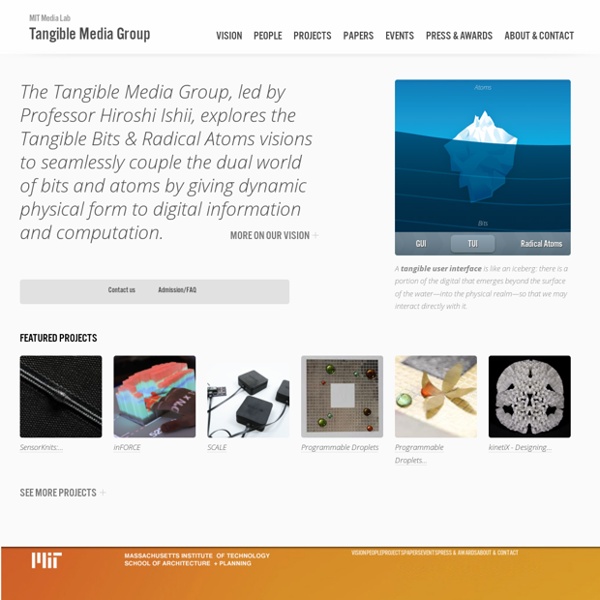



Viral Communications Group - MIT Media Lab - Front Page The Marble Answering Machine, devised by Durrell Tangible Interfaces Object-Based Media Group, MIT Media Laboratory Urp We introduce a system for urban planning - called Urp -that integrates functions addressing a broad range of the fields concerns into a single, physically based workbench setting. The I/O Bulb infrastructure on which the application is based allows physical architectural models placed on an ordinary table surface to cast shadows accurate for arbitrary times of day; to throw reflections off glass facade surfaces; to affect a real-time and visually coincident simulation of pedestrian-level windflow; and so on. We then use comparisons among Urp and several earlier I/O Bulb applications as the basis for an understanding of luminous-tangible interactions, which result whenever an interface distributes meaning and functionality between physical objects and visual information projectively coupled to those objects. Finally, we briefly discuss two issues common to all such systems, offering them as informal thought-tools for the design and analysis of luminous-tangible interfaces.
Tangible user interface A tangible user interface (TUI) is a user interface in which a person interacts with digital information through the physical environment. The initial name was Graspable User Interface, which is no longer used. Characteristics of tangible user interfaces[edit] Physical representations are computationally coupled to underlying digital information.Physical representations embody mechanisms for interactive control.Physical representations are perceptually coupled to actively mediated digital representations.Physical state of tangibles embodies key aspects of the digital state of a system According to,[1] five basic defining properties of tangible user interfaces are as follows: space-multiplex both input and output;concurrent access and manipulation of interface components;strong specific devices;spatially aware computational devices;spatial re-reconfigurability of devices. Examples[edit] A simple example of tangible UI is the computer mouse. Another example is the Topobo system. See also[edit]
MIT Media Lab: Design Ecology / Information Ecology Tangible Media Group The I/O Bulb and the Luminous Room are the two central ideas in a project whose goal is the pervasive transformation of architectural space, so that every surface is rendered capable of displaying and collecting visual information. An I/O Bulb is the conceptual evolution of the ordinary lightbulb: one which not only projects high resolution information but also simultaneously collects live video of the region it’s projecting onto. A Luminous Room is the structure that results from seeding an enclosed space with a multiplicity of coordinated I/O Bulbs÷enough, specifically, so that every location is treated by at least one I/O Bulb.
Miguel Chevalier enrobe le Maroc de mosaïques interactives Miguel CHEVALIER Digital Arabesques 2015 Fès par Claude Mossessian sur Vimeo. Sur les tapis interactifs de Miguel Chevalier on a la curieuse impression de marcher sur l'eau à la manière d'un gerris, comme si le monde de couleur qui s’étendait sous nos pieds était liquide, vivant. L’an dernier d’ailleurs, il avait projeté ses Digital Arabesques sur le front de mer de Sharjah. Les oeuvres de Chevalier s'inspire de la culture marocaine dans ce qu'elle a de plus esthetique : l'art des zelliges et des Mashrabiyas. Dans une nouvelle vidéo réalisé par son collaborateur de toujours Claude Mossessian, on découvre l’installation au Dar Batha de Fès, au Maroc, et elle donne l’impression d’y avoir toujours été. Digital Arabesques est la dernière installation de ce type réalisée par Chevalier après un jardin en fleurs fractales, cet un tapis de lumière dans un chateau italien. Digital Arabesques vient de quitter Fès pour rejoindre Agadir où elle sera exposée jusqu’au 20 mars. Images de l’artiste